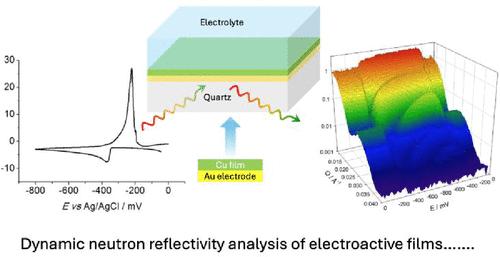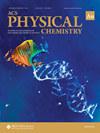Time-Resolved Spatial Distributions of Individual Components of Electroactive Films during Potentiodynamic Electrodeposition
IF 3.7
Q2 CHEMISTRY, PHYSICAL
引用次数: 0
Abstract
Of the attributes that determine the performance of electroactive film-based devices, the least well quantified and understood is the spatial distribution of the component species. This is critical since it dictates the transport rates of all the mobile species (electrons, counterions, solvent, analyte, and reactant) and the film mechanical properties (as exploited in actuator devices). One of the few techniques able to provide individual species population profiles in situ is specular neutron reflectivity (NR). Historically, this information is obtained at the cost of poor time resolution (hours). Here we show how NR measurements with event mode data acquisition enable both spatial and temporal resolution; the latter can be selected postexperiment and varied during the transient. We profile individual species at “buried” interfaces under dynamic electrochemical conditions during polypyrrole electrodeposition and Cu deposition/dissolution. In the case of polypyrrole, the film is homogeneous throughout growth; there is no evidence of dendrite formation followed by solvent (water) displacement. Correlation of NR-derived film thickness and coulometric assay allows calculation of the solvent volume fraction, ϕS = 0.48. In the case of Cu in a deep eutectic solvent, the complexing nature of the medium results in time-dependent metal speciation: mechanistically, dissolution does not simply follow the deposition pathway in reverse.

电位动力电沉积过程中电活性薄膜单个成分的时间分辨空间分布
在决定电活性薄膜设备性能的各种属性中,最难量化和理解的是成分物种的空间分布。这一点至关重要,因为它决定了所有移动物种(电子、反离子、溶剂、分析物和反应物)的传输速率以及薄膜的机械特性(如致动器装置中的利用)。镜面中子反射率 (NR) 是为数不多的能够在原位提供单个物种群概况的技术之一。从历史上看,获得这种信息的代价是较低的时间分辨率(小时)。在这里,我们展示了如何利用事件模式数据采集进行 NR 测量,从而实现空间和时间分辨率;后者可以在实验后进行选择,并在瞬态过程中进行改变。在聚吡咯电沉积和铜沉积/溶解过程中,我们对动态电化学条件下 "埋藏 "界面上的单个物种进行了剖析。就聚吡咯而言,薄膜在整个生长过程中都是均匀的;没有证据表明溶剂(水)置换后形成了枝晶。根据 NR 衍生的薄膜厚度和库仑测定法的相关性,可以计算出溶剂体积分数 ϕS = 0.48。就深共晶溶剂中的铜而言,介质的络合性质导致了随时间变化的金属种类:从机理上讲,溶解并不是简单地沿着沉积路径反向进行。
本文章由计算机程序翻译,如有差异,请以英文原文为准。
求助全文
约1分钟内获得全文
求助全文
来源期刊
CiteScore
3.70
自引率
0.00%
发文量
0
期刊介绍:
ACS Physical Chemistry Au is an open access journal which publishes original fundamental and applied research on all aspects of physical chemistry. The journal publishes new and original experimental computational and theoretical research of interest to physical chemists biophysical chemists chemical physicists physicists material scientists and engineers. An essential criterion for acceptance is that the manuscript provides new physical insight or develops new tools and methods of general interest. Some major topical areas include:Molecules Clusters and Aerosols; Biophysics Biomaterials Liquids and Soft Matter; Energy Materials and Catalysis

 求助内容:
求助内容: 应助结果提醒方式:
应助结果提醒方式:


